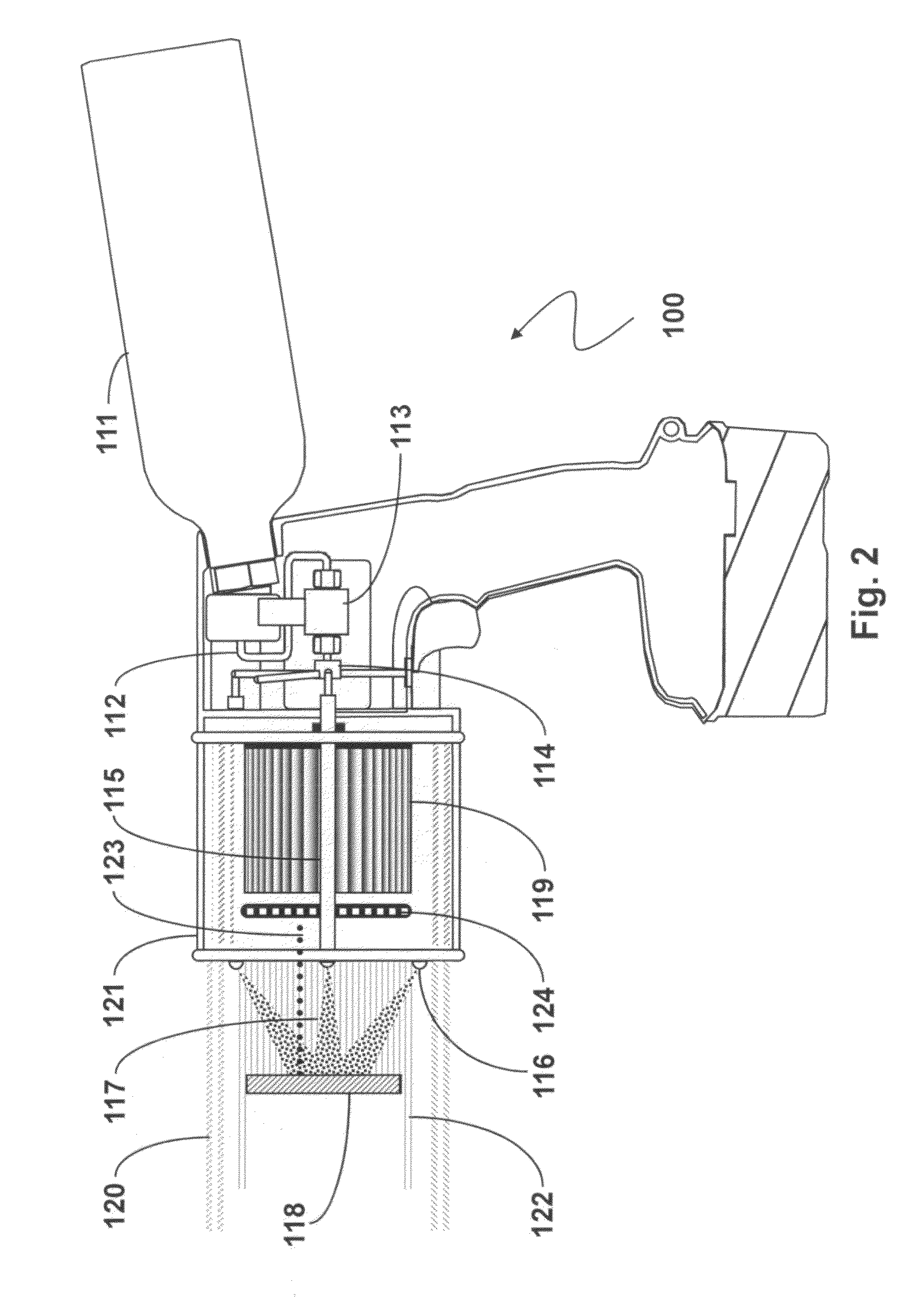Trace particle collection system
a trace particle and collection system technology, applied in the field of trace chemicals, can solve the problems of difficult to remove target particles by simple means, low momentum transfer methods, and difficult to remove target particles of explosives or narcotics from rigid surfaces, and achieve the effect of avoiding excessive emissions and high hardness
- Summary
- Abstract
- Description
- Claims
- Application Information
AI Technical Summary
Benefits of technology
Problems solved by technology
Method used
Image
Examples
first embodiment
[0028]Referring now to FIG. 2, shown is an example of a trace particle collection system that may be used in connection with the particle removal system methods described herein. While various embodiments may differ in details, FIG. 2 shows basic features of the system described herein. The particle collection system 100 illustrated in FIG. 2 is a handheld portable system, but the principles may be applied to larger, non-mobile systems. The particle removal portion of the system consists of a reservoir of liquid carbon dioxide 111, a connection tube 112, a pulsed valve 113, an expansion chamber 114, a connection tube 115 to a nozzle 116, and a spray 117 of the aerosol mixture containing frozen carbon dioxide particles and pressurized gas against the target surface 118. The particle transport portion of the system consists of an impeller fan 119 configured as a vortex attractor. The fan 119 blows an outward flowing stream of air 120 that is spinning about the axis of the impeller fan...
second embodiment
[0039]Referring now to FIG. 3, shown is an example of a trace particle collection system that may be used in connection with the particle removal system methods described herein. While various embodiments may differ in details, FIG. 3 shows basic features of the system described herein. The particle collection system 200 illustrated in FIG. 3 is a handheld portable system, but the principles may be applied to larger, non-mobile systems. The particle removal portion of the system consists of a reservoir of liquid carbon dioxide 211, a connection tube 212, a pulsed valve 213, an expansion chamber 214, a connection tube 215 to a nozzle 216, and a spray 217 of the aerosol mixture containing frozen carbon dioxide particles and pressurized carbon dioxide gas against the target surface 218. The particle transport portion of the system consists of an impeller fan 219 configured as a vortex attractor. The fan 219 blows an outward flowing stream of air 220 that is spinning about the axis of t...
third embodiment
[0042]Referring now to FIG. 4, shown is an example of a trace particle collection system that may be used in connection with the particle removal system methods described herein. While various embodiments may differ in details, FIG. 4 shows basic features of the system described herein. The particle collection system 300 illustrated in FIG. 4 is a handheld portable system, but the principles may be applied to larger, non-mobile systems. The particle removal portion of the system consists of a reservoir of liquid carbon dioxide 311, a connection tube 312, a pulsed valve 313, an expansion chamber 314, a connection tube 315 to a nozzle 316, and a spray 317 of the aerosol mixture containing frozen carbon dioxide particles and pressurized carbon dioxide gas against the target surface 318. The particle transport portion of the system consists of an impeller fan 319 configured as a vortex attractor. The fan 319 blows an outward flowing stream of air 320 that is spinning about the axis of t...
PUM
| Property | Measurement | Unit |
|---|---|---|
| pressure | aaaaa | aaaaa |
| distance | aaaaa | aaaaa |
| optimal distance | aaaaa | aaaaa |
Abstract
Description
Claims
Application Information
 Login to View More
Login to View More - R&D
- Intellectual Property
- Life Sciences
- Materials
- Tech Scout
- Unparalleled Data Quality
- Higher Quality Content
- 60% Fewer Hallucinations
Browse by: Latest US Patents, China's latest patents, Technical Efficacy Thesaurus, Application Domain, Technology Topic, Popular Technical Reports.
© 2025 PatSnap. All rights reserved.Legal|Privacy policy|Modern Slavery Act Transparency Statement|Sitemap|About US| Contact US: help@patsnap.com



